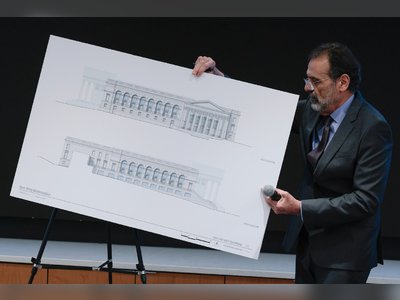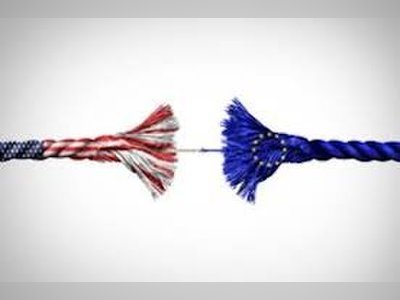Fed's Rate Cut Fails to Assuage Wall Street as Fewer Future Cuts Loom
Powell's Cautious Approach on Inflation Stirs Market Anxiety Amid Economic Optimism
In a decision that has rippled through global financial markets, the U.S. Federal Reserve slashed interest rates but signaled a conservative stance on future cuts, leaving investors unsettled.
The rate was trimmed by 0.25 percentage points to a range of 4.25%-4.5%, a move anticipated as the final monetary policy adjustment before the incoming Trump administration takes significant economic reins.
Jerome Powell, the Fed's chair, acknowledged the persistent challenge of inflation, labeling it 'stubborn' despite a broad downtrend since its alarming peak two summers ago.
Remarkably, the central bank’s caution lies in its projection of fewer rate cuts in 2025 than previously anticipated, a strategy meant to curb the inflationary pressure without precipitating economic malaise.
The immediate reverberation of this cautious outlook was felt on Wall Street, where the S&P 500 saw a drastic 3% decrease at the close, while the Nasdaq, with its tech-heavy portfolio, plummeted by 3.6%.
Such market reactions underscore the delicate balance the Fed must maintain in its dual mandate of fostering economic growth and ensuring price stability.
While inflation rates have decreased substantially from their generational heights, recent months have shown an unsettling uptick that complicates the narrative of economic recovery.
The broader U.S. economy, however, appears resilient, with November's employment data reflecting the addition of approximately 227,000 jobs, a testament to the ongoing robustness that Powell champions.
In his recent address, Powell emphasized optimism, highlighting, 'I think it’s pretty clear we have avoided a recession.
I think growth this year has been solid.
The U.S. economy has been remarkable.' His comments aimed to reassure a public increasingly wary of the tenacity of inflation and its impact on everyday life.
This macroeconomic landscape forms a crucial backdrop to the political arena, which saw Donald Trump leverage economic discontent and rising costs in his triumphant return to the White House.
However, Trump himself has alluded to the complexities of price reduction, admitting the formidable task of reversing inflation's upward trajectory.
Confronted with a frequently critical president-elect, Powell remains steadfast, intimating no plans to vacate his role despite potential pressures from the administration.
Trump's historical criticisms of the Fed and musings on its institutional independence pose further questions about the road ahead.
As Wall Street digests the implications of fewer anticipated rate cuts, the interplay between Fed policy and presidential expectations continues to map an uneasy course through an evolving economic landscape.
The true test will be whether the Fed’s cautious optimism can translate into tangible relief for a public grappling with economic realities that defy easy solutions.
The rate was trimmed by 0.25 percentage points to a range of 4.25%-4.5%, a move anticipated as the final monetary policy adjustment before the incoming Trump administration takes significant economic reins.
Jerome Powell, the Fed's chair, acknowledged the persistent challenge of inflation, labeling it 'stubborn' despite a broad downtrend since its alarming peak two summers ago.
Remarkably, the central bank’s caution lies in its projection of fewer rate cuts in 2025 than previously anticipated, a strategy meant to curb the inflationary pressure without precipitating economic malaise.
The immediate reverberation of this cautious outlook was felt on Wall Street, where the S&P 500 saw a drastic 3% decrease at the close, while the Nasdaq, with its tech-heavy portfolio, plummeted by 3.6%.
Such market reactions underscore the delicate balance the Fed must maintain in its dual mandate of fostering economic growth and ensuring price stability.
While inflation rates have decreased substantially from their generational heights, recent months have shown an unsettling uptick that complicates the narrative of economic recovery.
The broader U.S. economy, however, appears resilient, with November's employment data reflecting the addition of approximately 227,000 jobs, a testament to the ongoing robustness that Powell champions.
In his recent address, Powell emphasized optimism, highlighting, 'I think it’s pretty clear we have avoided a recession.
I think growth this year has been solid.
The U.S. economy has been remarkable.' His comments aimed to reassure a public increasingly wary of the tenacity of inflation and its impact on everyday life.
This macroeconomic landscape forms a crucial backdrop to the political arena, which saw Donald Trump leverage economic discontent and rising costs in his triumphant return to the White House.
However, Trump himself has alluded to the complexities of price reduction, admitting the formidable task of reversing inflation's upward trajectory.
Confronted with a frequently critical president-elect, Powell remains steadfast, intimating no plans to vacate his role despite potential pressures from the administration.
Trump's historical criticisms of the Fed and musings on its institutional independence pose further questions about the road ahead.
As Wall Street digests the implications of fewer anticipated rate cuts, the interplay between Fed policy and presidential expectations continues to map an uneasy course through an evolving economic landscape.
The true test will be whether the Fed’s cautious optimism can translate into tangible relief for a public grappling with economic realities that defy easy solutions.
Comments

John Doe 1 year ago
Federal Reserve rate cuts












